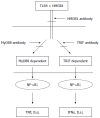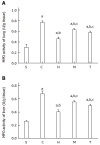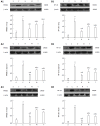TLR4-HMGB1-, MyD88- and TRIF-dependent signaling in mouse intestinal ischemia/reperfusion injury
- PMID: 26217083
- PMCID: PMC4507101
- DOI: 10.3748/wjg.v21.i27.8314
TLR4-HMGB1-, MyD88- and TRIF-dependent signaling in mouse intestinal ischemia/reperfusion injury
Abstract
Aim: To characterize high-mobility group protein 1-toll-like receptor 4 (HMGB1-TLR4) and downstream signaling pathways in intestinal ischemia/reperfusion (I/R) injury.
Methods: Forty specific-pathogen-free male C57BL/6 mice were randomly divided into five groups (n = 8 per group): sham, control, anti-HMGB1, anti-myeloid differentiation gene 88 (MyD88), and anti-translocating-chain-associating membrane protein (TRIF) antibody groups. Vehicle with the control IgG antibody, anti-HMGB1, anti-MyD88, or anti-TRIF antibodies (all 1 mg/kg, 0.025%) were injected via the caudal vein 30 min prior to ischemia. After anesthetization, the abdominal wall was opened and the superior mesenteric artery was exposed, followed by 60 min mesenteric ischemia and then 60 min reperfusion. For the sham group, the abdominal wall was opened for 120 min without I/R. Levels of serum nuclear factor (NF)-κB p65, interleukin (IL)-6, and tumor necrosis factor (TNF)-α were measured, along with myeloperoxidase activity in the lung and liver. In addition,morphologic changes that occurred in the lung and intestinal tissues were evaluated. Levels of mRNA transcripts encoding HMGB1 and NF-κB were measured by real-time quantitative PCR, and levels of HMGB1 and NF-κB protein were measured by Western blot. Results were analyzed using one-way analysis of variance.
Results: Blocking HMGB1, MyD88, and TRIF expression by injecting anti-HMGB1, anti-MyD88, or anti-TRIF antibodies prior to ischemia reduced the levels of inflammatory cytokines in serum; NF-κB p65: 104.64 ± 11.89, 228.53 ± 24.85, 145.00 ± 33.63, 191.12 ± 13.22, and 183.73 ± 10.81 (P < 0.05); IL-6: 50.02 ± 6.33, 104.91 ± 31.18, 62.28 ± 6.73, 85.90 ± 17.37, and 78.14 ± 7.38 (P < 0.05); TNF-α, 43.79 ± 4.18, 70.81 ± 6.97, 52.76 ± 5.71, 63.19 ± 5.47, and 59.70 ± 4.63 (P < 0.05) for the sham, control, anti-HMGB1, anti-MyD88, and anti-TRIF groups, respectively (all in pg/mL).Antibodies also alleviated tissue injury in the lung and small intestine compared with the control group in the mouse intestinal I/R model. The administration of anti-HMGB1, anti-MyD88, and anti-TRIF antibodies markedly reduced damage caused by I/R, for which anti-HMGB1 antibody had the most obvious effect.
Conclusion: HMGB1 and its downstream signaling pathway play important roles in the mouse intestinal I/R injury, and the effect of the TRIF-dependent pathway is slightly greater.
Keywords: C57BL/6 mouse; High-mobility group protein 1; Intestinal ischemia-reperfusion injury; Myeloid differentiation gene 88; Nuclear factor-κB translocating-chain-associating membrane protein.
Figures





Similar articles
-
[The role of high mobility group box 1 in the signaling pathways of mouse intestinal ischemia-reperfusion injury].Zhonghua Wai Ke Za Zhi. 2015 Mar;53(3):215-20. Zhonghua Wai Ke Za Zhi. 2015. PMID: 26269019 Chinese.
-
Overexpression of HMGB1 A-box reduced lipopolysaccharide-induced intestinal inflammation via HMGB1/TLR4 signaling in vitro.World J Gastroenterol. 2015 Jul 7;21(25):7764-76. doi: 10.3748/wjg.v21.i25.7764. World J Gastroenterol. 2015. PMID: 26167076 Free PMC article.
-
Dexmedetomidine Preconditioning Ameliorates Inflammation and Blood-Spinal Cord Barrier Damage After Spinal Cord Ischemia-Reperfusion Injury by Down-Regulation High Mobility Group Box 1-Toll-Like Receptor 4-Nuclear Factor κB Signaling Pathway.Spine (Phila Pa 1976). 2019 Jan 15;44(2):E74-E81. doi: 10.1097/BRS.0000000000002772. Spine (Phila Pa 1976). 2019. PMID: 29975331
-
Alleviation of non-alcoholic fatty liver disease by Huazhi Fugan Granules is associated with suppression of TLR4/NF-κB signaling pathway.Clin Investig Arterioscler. 2021 Sep-Oct;33(5):257-266. doi: 10.1016/j.arteri.2020.12.007. Epub 2021 Mar 31. Clin Investig Arterioscler. 2021. PMID: 33810882 Review. English, Spanish.
-
Innate Immune Regulations and Liver Ischemia-Reperfusion Injury.Transplantation. 2016 Dec;100(12):2601-2610. doi: 10.1097/TP.0000000000001411. Transplantation. 2016. PMID: 27861288 Free PMC article. Review.
Cited by
-
Pulmonary Epithelial TLR4 Activation Leads to Lung Injury in Neonatal Necrotizing Enterocolitis.J Immunol. 2016 Aug 1;197(3):859-71. doi: 10.4049/jimmunol.1600618. Epub 2016 Jun 15. J Immunol. 2016. PMID: 27307558 Free PMC article.
-
Activation of GPR81 aggravated intestinal ischemia/reperfusion injury-induced acute lung injury via HMGB1-mediated neutrophil extracellular traps formation.Int J Immunopathol Pharmacol. 2023 Jan-Dec;37:3946320231193832. doi: 10.1177/03946320231193832. Int J Immunopathol Pharmacol. 2023. PMID: 37698122 Free PMC article.
-
High-mobility group Box-1 regulates acute myocardial ischemia-induced injury through the toll-like receptor 4-related pathway.Int J Clin Exp Pathol. 2017 Aug 1;10(8):8344-8352. eCollection 2017. Int J Clin Exp Pathol. 2017. PMID: 31966685 Free PMC article.
-
Recent advances in allograft vasculopathy.Curr Opin Organ Transplant. 2017 Feb;22(1):1-7. doi: 10.1097/MOT.0000000000000370. Curr Opin Organ Transplant. 2017. PMID: 27898462 Free PMC article. Review.
-
Physical Exercise Repairs Obstructive Jaundice-Induced Damage to Intestinal Mucosal Barrier Function via H2S-Mediated Regulation of the HMGB1/Toll Like Receptors 4/Nuclear Factor Kappa B Pathway.Front Physiol. 2022 Feb 4;12:732780. doi: 10.3389/fphys.2021.732780. eCollection 2021. Front Physiol. 2022. PMID: 35185593 Free PMC article.
References
-
- Elias-Miró M, Jiménez-Castro MB, Rodés J, Peralta C. Current knowledge on oxidative stress in hepatic ischemia/reperfusion. Free Radic Res. 2013;47:555–568. - PubMed
-
- Kougias P, Lau D, El Sayed HF, Zhou W, Huynh TT, Lin PH. Determinants of mortality and treatment outcome following surgical interventions for acute mesenteric ischemia. J Vasc Surg. 2007;46:467–474. - PubMed
-
- Ding HS, Yang J, Chen P, Yang J, Bo SQ, Ding JW, Yu QQ. The HMGB1-TLR4 axis contributes to myocardial ischemia/reperfusion injury via regulation of cardiomyocyte apoptosis. Gene. 2013;527:389–393. - PubMed
Publication types
MeSH terms
Substances
LinkOut - more resources
Full Text Sources
Other Literature Sources
Research Materials

